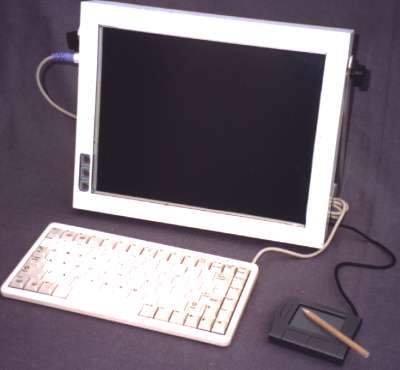
Page index:
other Solo pages
Other "green" technology
Links back:
![]()

Input device options
 |
Prototype Mk IIwith integral touch-screen, but shown here with an optional notebook-style miniature keyboard with 85 keys, measuring 347x157mm.The keyboard includes an inbuilt pointer actuator to the right which is acceleration sensitive and may be used instead of the touch screen input. |
The Solo is designed such that it can use a number of input devices simultaneously. Not only does this give greater resilience against systems failures, but certain input systems provide different levels of functionality.
Possible input devices include:
| Keyboard: USB, either full-size or a reduced footprint notebook-style as shown in the above photograph. This type omits the hex-keypad to the right, and is more suited for transportation in a standard-sized briefcase. | |
| Mouse: USB. 2-button for Linux or WinCE, 3-button for RISCOS. | |
| Pointer actuator: usually inbuilt to the keyboard, a movable button which accelerates the on-screen pointer in the direction in which it is pushed. See keyboard in picture at top of page. | |
| Touch-screen: either resistive, capacitive or surface acoustic wave (SAW). Resistive touch panels are cheaper and sensitive to any stick or stylus but the surface will eventually wear out. Capacitive panels require a human finger or special stylus to operate. When the Solo has a touch-screen installed it will trigger the use of an on-screen 'soft' keyboard, see below. Mouse clicks are produced either by tapping the screen or by using touch-buttons set into the bezel to the left of the screen. | |
| Hand-stick: a separate three-button 'wand' somewhat easier to use with a touch-screen than buttons inset into the bezel. Also replaces mouse buttons if these become non-functional. | |
| Touch-pad: see picture to right:
similar to a mouse, but better suited for hostile environments where dust could otherwise clog the mechanism. Although a touch-pad can be used with a finger, greater accuracy can be achieved by using a wooden stick or similar 'stylus'. Some keyboards also have an integral touch-pad. |
 |

